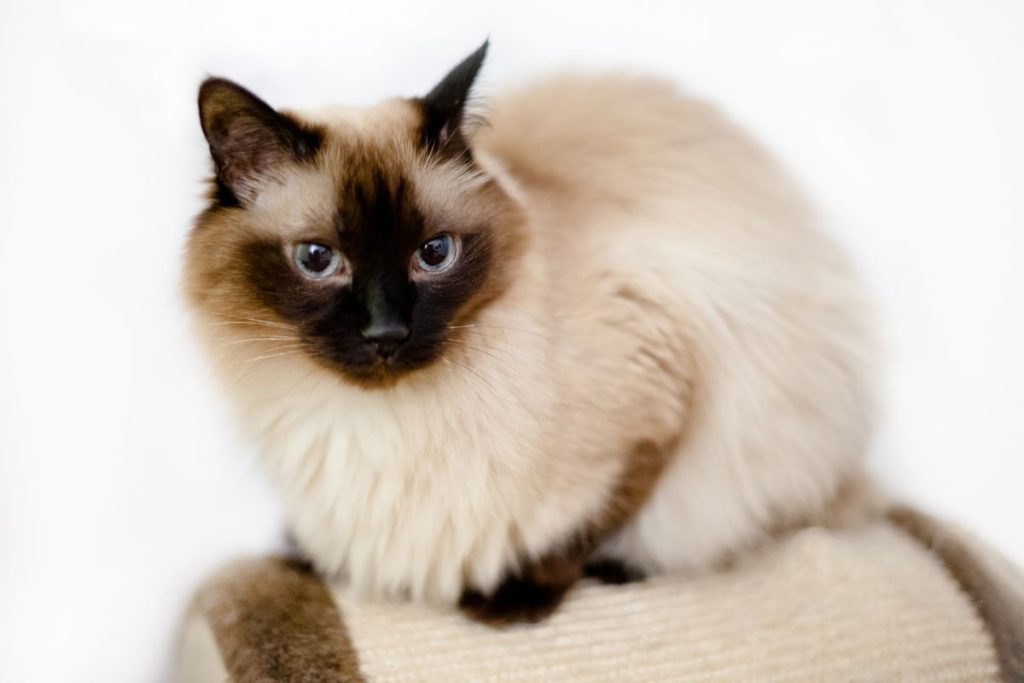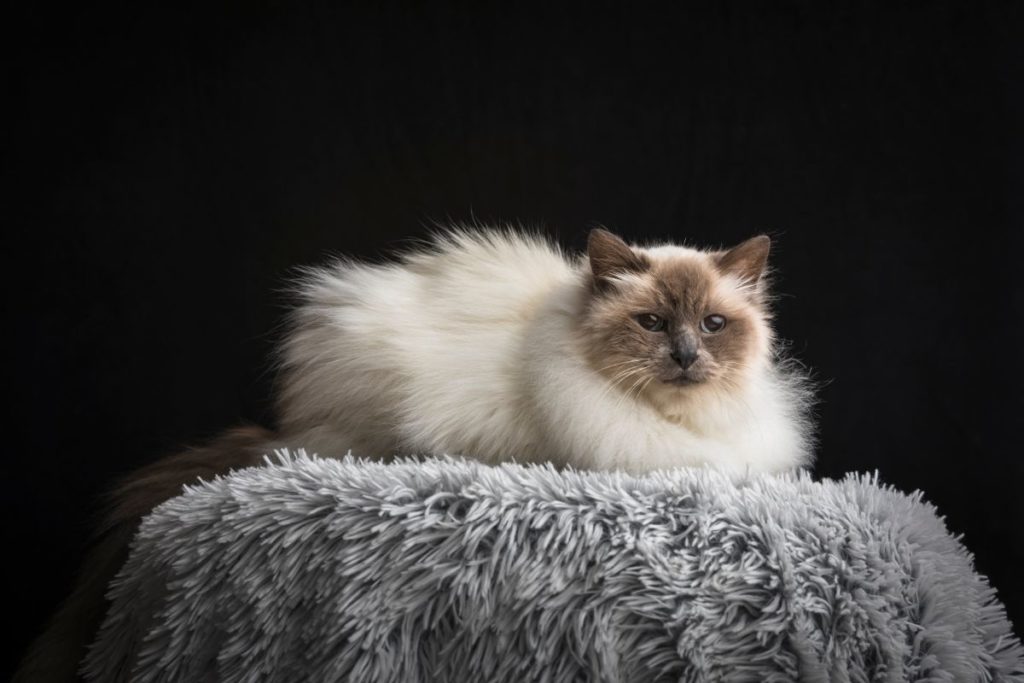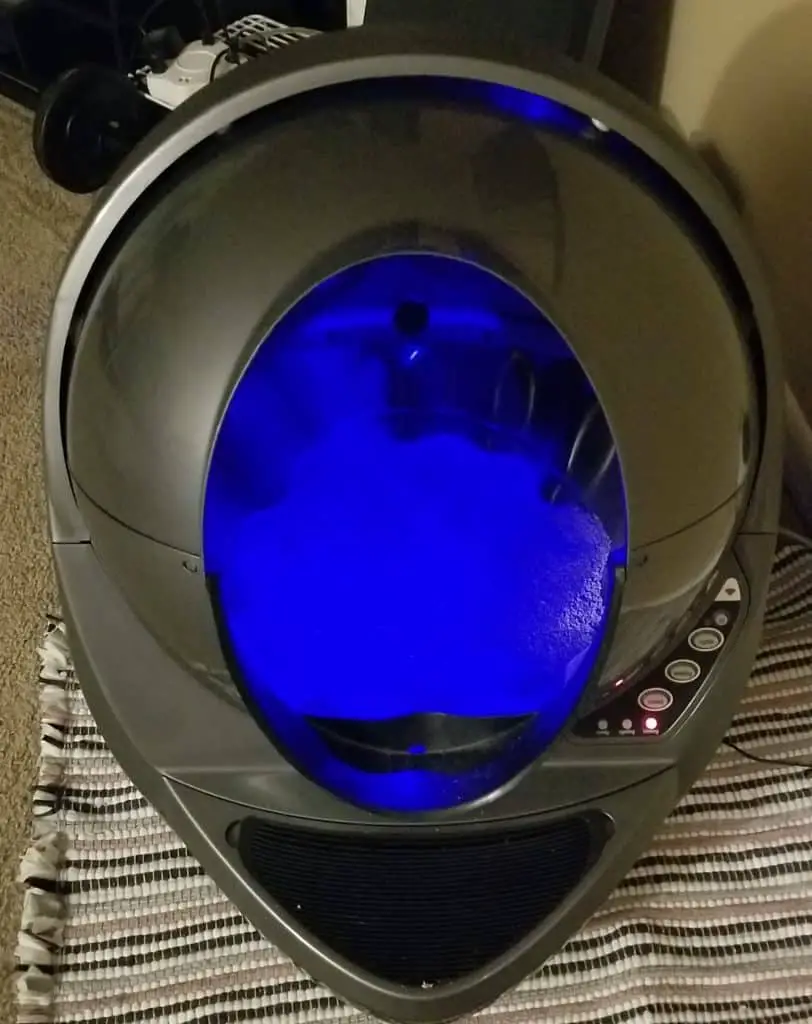More Meows is an Amazon Associate. As an Amazon Associate we earn from qualifying purchases. We may also earn commissions if you purchase products from other retailers after clicking on a link from our site.
Birman cats are well know due to their beautiful appearance and excellent personality. I put a list together to show why Birman cats are the best. So read on and learn more about the Birman cat!
1. Birman Cat Appearance
While it’s true that Birmans have a robust, athletic frame, it is disguised somewhat by the drape of the Birman’s coat. Most breed registries describe Birmans as having muscular, strong, stocky bodies.
This description always brings to mind a football player or perhaps a Pitbull dog, hardly congruent with the graceful elegance of the Birman.
Some fanciful breeders and cat enthusiasts maintain that the Birmans light-colored areas have a sheen reminiscent of gold dust.
The Birmans proportions are balanced and symmetrical, creating a pleasing picture of moderation and sophistication. This ancient cat breed epitomizes the pinnacle of old-world sophistication, elegance, and decorum.
All Birmans have round, curious eyes in the most stunning sapphire color. The bluer the color, the better it is! The Birman’s eye color resembles the deep blue of the seas far offshore, set aflame by the glittering sun.
2. Birman Color and Patterns
Birmans come in a range of gorgeous colors, including:
- Chocolate
- Seal
- Lilac
- Red
- Cream
The dark points of the Birman may be solid or show a tabby or tortoiseshell pattern. A tortoiseshell pattern is so named because the patterning resembles the large blurred rosettes of a tortoise. In contrast, the tabby pattern shows less pattern repetition in the dots, swirls, and stripes weaving their way through a tabby’s coat.

3. Birman Color Points
Birmans are famous for their gorgeous colorpoint patterns. A colorpoint pattern is a pattern affecting the distribution of pigment along their body. As a result, only the ears, face, tail, and legs are graced with a dark color.
The body and other areas must be white or cream, showing good contrast between the dark points.
Colorpoint is a recessive gene, and cats must be homozygous (i.e., have two copies of the gene) to express the colorpoint patterning.
Colorpoint parents will always give birth to colorpoint kittens. However, parents of two solid-colored heterozygous (i.e., only having one copy of the gene) can give birth to colorpoint kittens.
4. Birman Cat Paws
Birmans are said to be a “mitted” cat breed. The front paws have white gloves extended to the third joint, while the back legs have white gloves covering the front of the paws. The back gloves then narrow into laces that extend up the back of the leg, halfway up the hock.
The KIT gene is responsible for their gloves, and like the colorpoint gene, the KIT gene is recessive. Therefore, Birmans need two copies of this gene to have gloves.
Ragdolls a descendent of Birmans, also demonstrates gloving, but the genetics controlling the Ragdoll gloves are not the same as in Birmans.

5. Birman Cat Grooming
Like all longhaired cats, Birmans require regular grooming; unlike most longhaired cats, Birmans do not need to be groomed every day.
Birmans have a semi-long single-layered coat. Therefore, they do not have the undercoat characteristic of most long breeds and do not shed as extensively as a true longhaired cat.
Their coats are medium to long and have a silky texture. The single-layered semi-long coat of the Birman does not tangle easily.
It is usually sufficient to brush a Birman with a wide-tooth metal comb once a week. However, as spring arrives, Birmans shed their heavy winter coats for a lighter summer coat. During this shed, Birmans benefit from more regular brushing.
Birmans adore attention and will enjoy their weekly brushing if it is introduced in a calm, relaxed manner.
Your Birman needs to have their nails clipped once a month and will need to be given a bath when necessary.
Many cats, Birmans included, find being immersed in water traumatic. It is much easier and kinder for you to use a damp sponge to thoroughly wet your Birman in preparation for bathing. Remember to use cat-specific shampoo as their skin pH is different from humans and dogs.
6. Birman Cat Size
Perhaps I am alone in my neuroticism, but I am always anxious about accidentally hurting a very delicate, fragile cat, like the Munchkin or Singapura. They’re so small that it would be easy to seriously hurt them by losing your balance and accidentally stepping on one of their delicate paws.
However, the likes of the giant Maine Coon, Norwegian Forest Cat, and Savannah can make them difficult housemates to have, especially if you live in a small apartment. These outsized cats wreak havoc on house fittings, ornaments, and delicate furniture.
They also pose a significant trip hazard to owners with an unsteady gait.
How Big is a Birman Cat?
Birmans have heavily boned stocky frames, made to appear even larger by their bouffant hairstyles. TICA classifies the robust Birman as a medium to large-sized cat weighing between 10lbs to 12lbs and standing at 8″ to 10″ at the shoulder.
Unlike the fragile fairy-like Munchkin and the overlarge Maine Coon, the size of the Birman is perfect. The Birman’s build inspires confidence without making the prospective owners apprehensive about owning a super-sized cat.
There is confidence to be found in the knowledge that the robust Birman can withstand a few knocks without falling apart.
No one wants to hurt their kitties, but accidents happen, toddlers trip and fall, dogs have crazy days, tables fall over, and kittens underestimate the height of a jump. The Birman’ are more than capable of dealing with all these life mishaps without being hurt or overwhelmed.
I can imagine goldilocks going through all the cat breeds saying “too small, too big” and then finally pointing at the Birman, saying, “him, he’s just the right size for a girl to love.”
Here are some of my favorite cat products
In addition to checking out some other More Meows articles, I hope you’ll check out some of my favorite cat products as well. These are affiliate links, so if you end up using them, I’ll get a commission at no extra cost to you. These are the products I really do find most helpful.
Litter Box: I started out with normal, traditional litter boxes for my cat. Then, I tried this automatic litter box on Amazon (affiliate link), which helped reduce the litter upkeep. Finally, I am now a believer in the Litter-Robot 3 Connect on Amazon (affiliate link). This robotic litter box is not for everyone based on the price tag, but for me the benefits (very little upkeep, works efficiently, clean, mobile app) far outweighed the cost.

Cat Tree: I have purchased a couple of this Amazon Basics Cat Tree on Amazon (affiliate link). My cat spends a lot of time on and around this cat tree, which I position near my sofa. She uses the scratching posts on this cat tree multiple times a day, which means she is not scratching the sofa instead.
Cat Water Fountain: I love this cat water fountain on Amazon (affiliate link). There are three main benefits to having a water fountain like this for your cat. The first benefit is that it keeps water running so that your cat doesn’t need to drink still water. The second benefit is that it filters the water. The third benefit is that it will keep your cat hydrated!
7. Are Birman Cats Good Pets?
Yes, Birman cats are good pets. Birman cats are well-suited to live In any cat-friendly home. Birman cats have much love to give to their humans and are friendly to children.
Cat’s are divas, or at least that is what social media wants you to believe; however, this is not true for all cats.
Some cats like the Savannah and Bengal need experienced owners to handle them as they can be intense, highly strung, and on occasion, aggressive cats.
Like the Savannah, Bengal, and Ocicat, hybrid cats tend to be bigger than domestic cats with a powerful hunt instinct and should not live in homes where small creatures are let loose. Birds, hamsters, chinchillas, and guinea pigs are little more the snacks for the hybrid cats, especially the F1 crosses.
The Nebelung and Norwegian Forest Cat are large, dignified cats who dictate the terms of their human relationships. Both of these cats do well with routine and structure while living in a quiet and orderly household. A less politically correct way of saying this is that these cats and many others do not do well when living with young children and dogs.
The Peterbald, Sphynx, and Donskoy are incredibly time intensive cats due to the added skincare required to keep them healthy. People with busy schedules and chaotic lives cannot take on the responsibility of a hairless cat.
Now that we’ve gone through all the households these cats can’t live in, let’s look at which cat can live in ALL these households. You guessed it! The Birman will be more than content living in any cat-friendly home.
8. Birman Cat Personality
The Birman’s sweet amiable temperaments and unflappable nature make them perfect cats for young kids and dogs. Their sedentary ways and low-energy lifestyle are ideal for older people or people with chronic illness or disability.
They are supremely forgiving and don’t hold grudges, unlike some cats I could mention! After sharing their homes with the friendly, undemanding Birman, even novice owners will become cat converts.
Birmans do well in any home where all their physical needs are met, and they can participate in family activities and receive plenty of attention. Families “owned” by a Birman need to get comfortable with having a Birman shadow 24/7.
Birmans are sometimes known as “Velcro” cats and thrive when receiving positive attention. However, it is difficult to explain to non-Birman owners how attached the Birman becomes to its people.
To summarise the type of household that would suit a Birman:
- Cat-friendly dogs
- Children of any age
- First-time cat owner
- Experienced cat owner
- Apartment living
- An older person, person with disability or chronic illness
- Household members enjoy and want a fluffy cat
- Small household pets, e.g., guinea pigs, parrots, hedgehogs, etc.
To summarise the type of household that would not suit a Birman:
- Family member(s) living at home is allergic to cats
- Dogs with a history of attacking and hurting cats
- Families who are away a lot, leaving their cat entirely alone for hours on end
- Families who don’t like longhaired cats and don’t have time to groom their Birman
9. Birman Health Problems
Birmans have relatively few genetic conditions when compared to other purebred cats. As a result, a healthy Birman can easily live between 9 to 15 years old, with many living well past 15.
Birmans have a genetic predisposition to a handful of different hereditary illnesses. However, almost all of these hereditary conditions can be tested for prior to breeding, ensuring that the “bad genes” don’t get passed onto any offspring.
Losing a beloved pet to a preventable illness at a young age is a devastating loss to work through. However, knowing that your cherished Birman will be with you for more than a decade, possibly even two decades, is definitely a pro for buying a Birman.
10. Birman Cat Show
All major cat registries, including the Cat Fanciers Association (CFA), The International Cat Association (TICA), and Fédération international Féline (FIFe), recognize the Birman as a distinct breed.
Competitions that run under the auspices of domestic cat associations regularly have classes opened to Birman cats. Additionally, the laid-back Birman is an easy cat for a novice to show.
11. Are Birman and Ragdoll Cats the Same?
No, Birman and Ragdoll cats are not the same, but the Birman was used to create the Ragdoll cat. Ragdolls share some personality traits with the Birman due to the ancestry, such as a gentle demeanor.
Birmans are an ancient breed, existing for centuries, and as such, their books have been closed for many years. There are no permissible outcrosses when breeding Birman cats. Despite their own breeding registry being closed, Birmans played a pivotal role in forming a new cat breed.
Ragdolls were created by breeding Josephine, a feral white cat, to a laid-back seal-point Birman male. The gentle, loving nature was a legacy of both parents, but the striking colorpoint patterns seen in the Ragdoll are the Birman’s influence.
The cat world was blessed by the development of the ever-patient people-orientated Ragdoll, which could not have been bred without the Birman.
12. Birman Cat Legend
The true origin story of Birman cats has been lost to the shrouds of time. However, we have been gifted a legend starring the first Birman. In truth, the legend is probably more romantic than the true story of how Birmans came to be.
Why Are Birman Cats Sacred?
The story goes that the Kittah priests of a Burmese temple loved their colony of a hundred cats, whom they cared for daily. One golden-eyed white cat, Sinh, formed a special bond with the High Priest Mun-Ha.
Tsun Kyan Kse
One night the temple, Lao-Tsun built for the golden goddess Tsun-Kyan-Kse was raided. Mun-Ha fought off the would-be robbers as they attempted to steal the golden statue of Tsun-Kyan-Kse. Mun-Ha fought so hard that his body became overstressed and suffered a fatal heart attack.
Death And Transformation
As Mun-Ha lay dying, Sinh jumped onto his beloved master’s chest, hissing to defend his dying friend. Sadly Sinh could not save Mun-Ha, and Mun-Ha’s spirit left his earthly body to enter Sinh’s.
The transmutation of the human spirit to the cat caused Sinh to change color. His face, legs, and tail turned the color of the earth while his paws remained the pure white of freshly fallen snow, indicating the purity of Mun-Ha’s spirit.
As Mun-Ha died, Sinh looked in grief upon the statue of Tsun-Kyan-Kse. The goddess saw Sinh’s suffering and sacrifice and reached out to him. In touching him, she turned his golden eyes blue and bestowed a gauzy coat of shimmering gold to lie lightly across his back.
Where Did Birman Cats Originate From?
Sinh lived for seven more days before passing to the other side to be with his master. The young priests despaired that the blessed animal had gone, but as they raised their heads, they saw that the remaining ninety-nine cats had received the same blessing as Sinh, and so the Birman was born.
Birmans are still sometimes referred to as the “Sacred Cats of Birma.”
Conclusion
The Birman is well-known to be charismatic and lovable. I made this list of 12 reasons that Birman cats are the best to show that there are many reasons to love the Birman cat. Some examples of good reasons that Birman cats are the best are the Birman size, health, and personality! If you enjoyed this article, please read a few more:
- Is it Bad to Kiss Your Cat? (Cat Love and Affection): Click Here To Read.
- Are Female Cats Friendly: Click Here To Read.
- 13 Beautiful Cat Breeds Similar to Siamese Cats: Click Here To Read.
